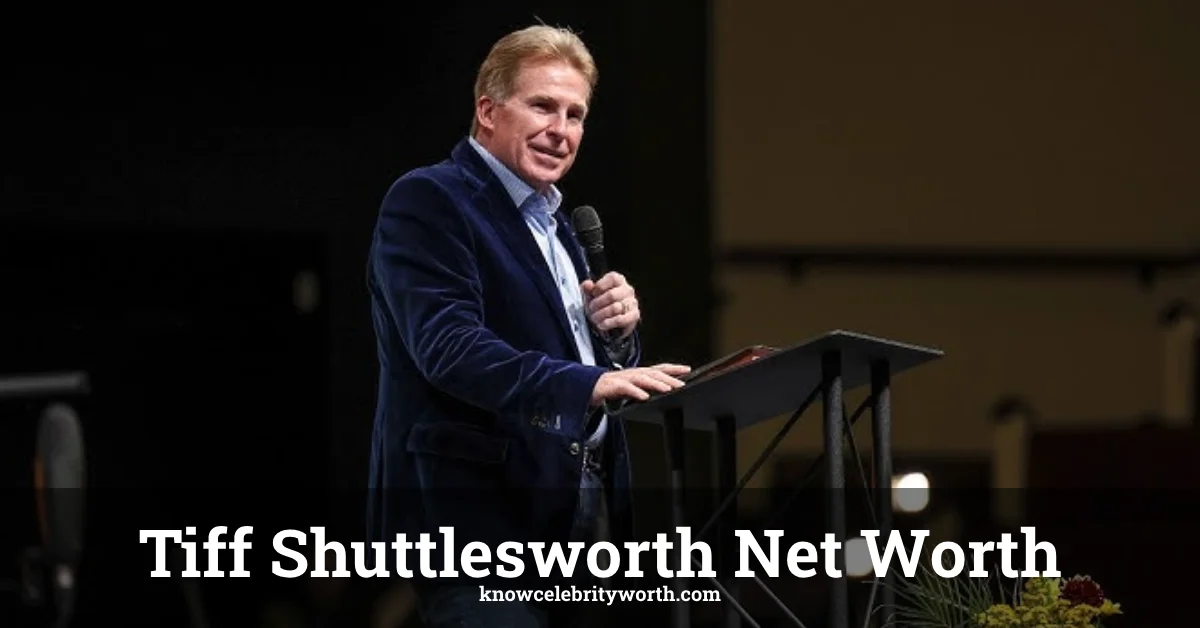When you search for info about Tiff Shuttlesworth’s money situation, you’ll find quite a range of numbers. How much is this well-known evangelist really worth?
Let’s clear up the confusion and get to the facts about his wealth in 2025.
Tiff Shuttlesworth Net Worth
The financial story of Tiff Shuttlesworth shows some interesting contrasts depending on where you look. Current estimates of his net worth range from $1.5 million to as high as $5 million. Why such a big difference in these numbers?
The varied estimates come from how different sources calculate his assets and income streams. Some reports focus mainly on his public ministry activities, while others include his broader business ventures, investments, and media presence.
Looking at the most reliable sources, Tiff Shuttlesworth’s actual net worth likely falls around $3 million as of early 2025. This figure represents a middle ground between the varying estimates and takes into account his multiple revenue sources.
For comparison, this puts him in the mid-range of successful evangelists but well below mega-pastors like Joel Osteen, whose net worth exceeds $50 million. Shuttlesworth’s wealth comes from a mix of traditional religious leadership and modern digital entrepreneurship.
His income flows from several key sources. Ministry donations make up a significant portion, with regular contributions from followers who support his religious work. Book sales add substantially to his earnings, with several published works on Christian living and faith. Speaking fees from appearances at churches, conferences, and events across the country bring in additional revenue. His growing podcast has attracted sponsorships that now contribute meaningfully to his yearly income.
While $3 million might seem substantial, it’s worth noting that established evangelists with national platforms typically build net worth in this range after years of ministry work. The financial side of religious leadership often raises questions, but Shuttlesworth has been relatively transparent about using ministry funds for expansion rather than personal luxury.
Career

Tiff Shuttlesworth began his journey as a small-town preacher before gradually building a wider following. His rise to prominence came through a combination of charismatic speaking, relatable teaching style, and early adoption of digital platforms to spread his message.
Today, he’s recognized across multiple states as a dynamic evangelist who blends traditional biblical teachings with contemporary applications. His approach connects especially well with younger Christians looking for faith guidance that speaks to modern challenges.
The cornerstone of Shuttlesworth’s public presence is his ministry organization, which hosts regular events and services. Unlike some larger ministries with permanent megachurch buildings, Shuttlesworth has kept his operation relatively mobile, focusing on tours and guest appearances rather than maintaining extensive physical properties.
1. Media Presence
Shuttlesworth’s financial growth accelerated when he expanded into digital media. His podcast, “Lost Lamb Association,” reaches thousands of listeners weekly and has become a significant platform for his teachings. The podcast combines spiritual guidance with discussions about everyday life challenges, making faith concepts accessible to casual listeners.
His social media presence has grown steadily across platforms. On Instagram, he maintains an active account with regular posts combining ministry updates, personal reflections, and snippets from his daily life. His Twitter/X following, while smaller, provides another channel for quick thoughts and engagement with followers.
YouTube has become another valuable platform, with recorded sermons and teaching sessions drawing consistent viewership. These videos not only expand his reach but also generate advertising revenue that contributes to his overall income.
2. Revenue Streams Breakdown
Shuttlesworth’s financial portfolio includes several distinct income channels:
- Direct ministry support remains fundamental, with regular donations from supporters funding both his personal salary and wider ministry activities. Many evangelical leaders draw salaries from their ministries, and Shuttlesworth likely follows this model, though specific salary figures aren’t publicly disclosed.
- Book sales represent another significant revenue source. He has authored several books on faith topics that continue to sell through both religious bookstores and mainstream retailers. While not bestsellers in the broader market, his books maintain steady sales among his follower base.
- Digital monetization has become increasingly important. His podcast attracts sponsorships from companies targeting Christian consumers, including Bible apps, Christian conference promoters, and faith-based merchandise brands. YouTube ad revenue, while modest compared to secular content creators with similar follower counts, provides a steady additional income stream.
- Speaking engagements round out his revenue mix. Shuttlesworth commands speaking fees for appearances at churches, conferences, and special events. These fees typically increase as a speaker’s reputation grows, suggesting his per-event earnings have likely risen over time.
Merchandise sales, including recorded sermons, study materials, and branded items, provide another income channel that leverages his name recognition among followers.
Controversies
Like many religious figures who achieve financial success, Shuttlesworth’s net worth has sparked both support and criticism. Many followers view his financial status as a natural result of his hard work and the value he provides through ministry and teaching. They point to his relatively modest lifestyle compared to some wealthier televangelists as evidence of financial responsibility.
Supporters often highlight how Shuttlesworth reinvests in his ministry rather than focusing on personal luxury. His continued travel schedule and hands-on approach to ministry work suggest an ongoing commitment to his calling rather than retirement into wealth.
Critics, however, raise questions common to many successful religious leaders – particularly around the ethics of wealth accumulation through ministry work. Some question whether ministry donations should translate into personal wealth, reflecting broader debates about money in religious leadership.
Shuttlesworth has addressed these criticisms occasionally in interviews and sermons, emphasizing that ministry leaders deserve fair compensation for their work while acknowledging the responsibility that comes with managing donations from supporters.
Unlike some higher-profile evangelists, Shuttlesworth has largely avoided major financial scandals or controversies. He doesn’t promote the “prosperity gospel” that explicitly links faith with financial blessing, which has helped him avoid some of the criticism directed at preachers who focus heavily on wealth messages.
Net Worth vs. Other Evangelical Leaders
When placed alongside other evangelical leaders, Shuttlesworth’s financial status tells an interesting story. His estimated $3 million net worth places him firmly in the middle tier of successful ministries – far from the wealth of megachurch pastors like Joel Osteen (estimated at $50+ million) or Steven Furtick (estimated at $20+ million).
This middle-range position reflects Shuttlesworth’s focused approach to ministry. Rather than building a massive church empire with television networks and global reach, he has concentrated on a more direct connection with followers through travel, speaking, and digital content.
His financial model appears more sustainable than some ministry leaders who focus heavily on expensive properties and lavish lifestyles. By keeping overhead costs relatively low and diversifying income across books, speaking, and digital content, Shuttlesworth has built wealth gradually rather than through high-risk expansions.
For context, the average local church pastor in America earns between $50,000 and $100,000 annually, making Shuttlesworth’s accumulated wealth significantly above average for religious leaders. However, when compared specifically to traveling evangelists with national platforms, his financial status aligns with typical patterns in the field.
The difference in wealth between Shuttlesworth and top-tier evangelists often comes down to scale and business approach. The wealthiest religious leaders typically own extensive media properties, real estate holdings, and business ventures beyond their core ministry work. Shuttlesworth’s more focused approach has led to solid but not extreme wealth accumulation.
What sets his financial journey apart from many peers is his early adoption of digital platforms. While some traditional evangelists struggled to transition to online ministry, Shuttlesworth embraced podcasting and social media relatively early, creating revenue streams that have grown increasingly valuable.
How Tiff Shuttlesworth Built His Wealth?
The growth of Shuttlesworth’s net worth didn’t happen overnight. His financial journey followed a path common to many successful evangelists, beginning with small local ministries before expanding to regional recognition and eventually building national reach.
Early in his career, speaking fees would have been modest, with many appearances likely paid through love offerings (voluntary donations) rather than guaranteed payments. As his reputation grew, these fees increased substantially, creating more financial stability.
Book publishing typically followed his growing platform. First books often earn modest advances for religious authors, but subsequent works command better terms as publishers recognize an established audience. Shuttlesworth’s publishing history shows this progression, with later works likely generating more significant royalties.
The addition of digital revenue streams marks the most recent phase of his financial growth. Podcast sponsorships, in particular, can be lucrative for hosts with dedicated audiences, with rates typically calculated on a cost-per-thousand-listeners basis. As his podcast audience grew, these sponsorships became increasingly valuable.
What’s particularly notable about Shuttlesworth’s wealth-building approach is how he’s leveraged his content across multiple platforms. Sermons delivered live become YouTube videos, which then generate clips for social media, which drive traffic back to his books and podcast. This content ecosystem maximizes the value of each teaching session.
Managing Wealth in Ministry Contexts
How Shuttlesworth manages his wealth offers insights into the broader question of money in ministry. Unlike some religious leaders who form complex networks of organizations and businesses, Shuttlesworth appears to maintain a relatively straightforward financial structure.
His personal finances likely remain somewhat separate from ministry operations, following standard practices for non-profit religious organizations. This separation helps address potential concerns about the use of donated funds while allowing for appropriate compensation for his work.
Tax filings for religious organizations aren’t publicly available in the same way as other non-profits, making detailed financial analysis difficult. However, Shuttlesworth has not faced public allegations of financial mismanagement that sometimes affect other evangelists.
Financial transparency in ministry remains a challenging topic across evangelical Christianity. Some leaders opt for full disclosure of salaries and spending, while others maintain privacy around compensation details. Shuttlesworth appears to fall somewhere in the middle of this spectrum, acknowledging his financial blessing while not publishing detailed statements.
Financial Trajectory
What might the future hold for Tiff Shuttlesworth’s net worth? Several factors will likely influence his financial path in coming years.
His digital presence continues to grow, suggesting potential for increased revenue from online sources. As podcast listening continues to expand among Christian audiences, his established platform positions him well for continued growth in this area.
Book publishing remains a viable income source, though the religious publishing market faces the same challenges as the broader book industry. His established reader base provides a foundation for future releases.
Speaking engagements will likely continue as a core revenue stream, with fees potentially increasing as his visibility grows further. The post-pandemic return to in-person events has revitalized this income source for many traveling ministers.
The biggest variable may be how he chooses to expand or maintain his current ministry model. Some evangelists eventually transition toward building permanent facilities or launching television ministries, which can either accelerate wealth growth or create financial challenges depending on execution.
What seems clear is that Shuttlesworth has built a financial foundation that provides both personal security and ongoing ministry funding. His diverse revenue streams create resilience against changes in any single income source.
The Bigger Picture
Tiff Shuttlesworth’s net worth represents more than just a number – it reflects broader questions about success, compensation, and ethics in religious leadership. His financial journey illustrates how modern evangelists often blend traditional ministry with entrepreneurial approaches to build sustainable careers.
For those following his ministry, the question isn’t simply how much money he has, but rather how that wealth aligns with his stated values and teaching. Shuttlesworth has generally avoided making wealth a centerpiece of his message, focusing instead on core biblical teachings while building his financial foundation through multiple channels.
What makes his story particularly relevant in 2025 is how it demonstrates the changing economics of religious leadership in a digital age. As church attendance patterns shift and online ministry grows, leaders like Shuttlesworth who successfully navigate both worlds may continue to find financial success while maintaining their spiritual mission.
